Circular connectors have long been a cornerstone of the interconnect industry. Their compact form, mechanical durability, and adaptability make them indispensable in harsh environments, particularly across aerospace and defense applications.
To understand why these connectors remain so vital today, it helps to explore how standardized circular designs first took root in aerospace and defense applications.
The Enduring Role of Circular Connectors in Harsh Environments
The widespread adoption of circular connectors within the aerospace industry has been made easier using standardized designs. Military designers have long realized the value of creating common designs to ensure the interoperability of connectors from multiple sources. Over the years, many standards have been created for the defense industry. These specify every aspect of product design, from the dimensions of the mating face to the methods used for labeling and packaging.
| Connector | Introduced | Typical Use | Key Features / Differences |
|---|---|---|---|
| MIL-DTL-5015 | 1939 | Military vehicles, aircraft | First standardized circular connector; rugged, threaded coupling; limited EMI protection |
| MIL-DTL-26482 | 1952 | Avionics, military electronics | Quick coupling; moderate contact density |
| MIL-DTL-26500 | 1965 | Military and commercial aviation | Sealed or unsealed variants; vibration resistant |
| MIL-DTL-83723 | 1973 | Aerospace harnesses, engines | EMI shielding; environmental sealing |
| MIL-DTL-38999 | 1976 | Defense, aerospace, space | High contact density; EMI protection; triple-start threads |
| Cinch MD801 | 2010s | UAVs, robotics, wearable technology | D38999-grade EMI shielding and durability in a rugged, compact form factor |
Table 1: Evolution of Circular MIL-SPEC Connectors
These standards are now commonly used as shorthand for military connectors. Their consistent use has made them a recognized reference across the industry. Standards such as the MIL-DTL-5015 and MIL-DTL-26482 series have been in constant use for well over six decades. They have been widely adopted beyond their originally intended role as industrial users have discovered the versatility and strength of military circular types. It is now common to see these MIL-SPEC connector types in commercial applications.
The Introduction of High-Density Electronics
The design of the connectors themselves reflects the technological limitations and design priorities of their era. To cater to the simpler electronics found in early generations of aircraft, the original standards used large pins and robust housings.
Technology evolved rapidly. The rise of microelectronics in the 1960s and 70s, alongside digital computing, marked a turning point in aerospace design. The rise of the integrated circuit and the microchip revolutionized the capabilities of computer systems. For the first time, computers were small enough to be carried by a single person. More importantly, they became small enough to be mounted in confined spaces.
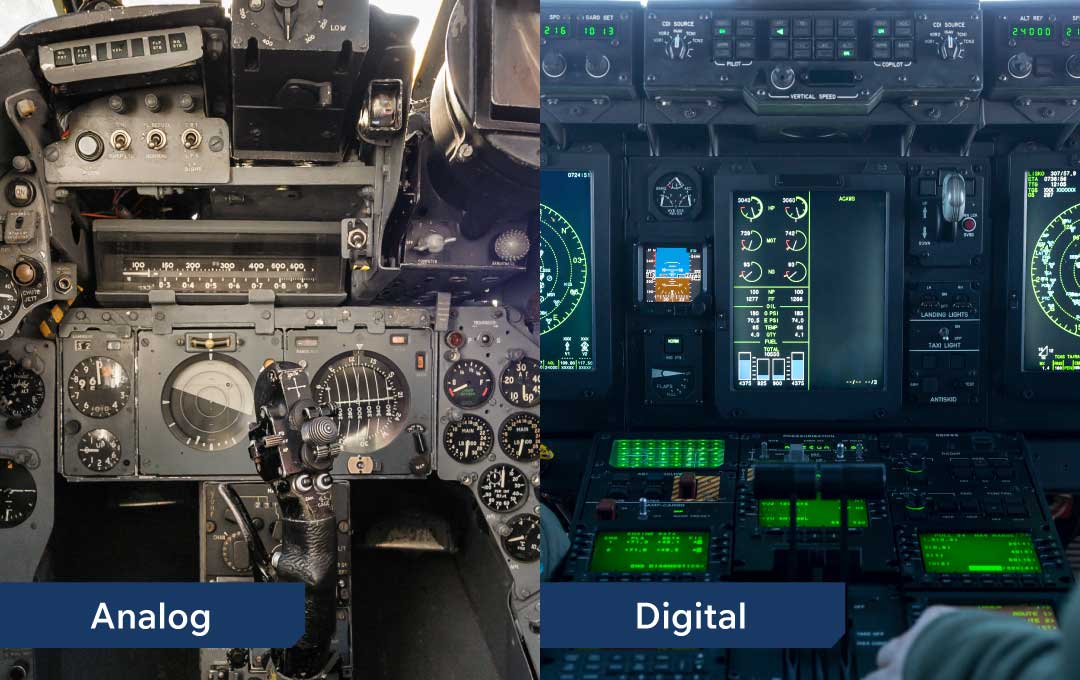
Figure 1: Transition from analog to digital cockpits reflects broader shifts in aerospace electronics, from large, mechanical instruments to compact, high-speed digital systems.
New Capabilities of Modern Aerospace Systems
As aerospace systems transitioned from analog to digital, one of the most transformative developments was the emergence of Fly-By-Wire (FBW) technology in the 1960s. This concept replaced the complex web of mechanical cables, pulleys, and hydraulic linkages with electronic interfaces that transmitted pilot inputs to control surfaces via electrical signals.
The increase in capability led to a broad range of innovations in the aerospace industry. An entire generation of combat aircraft was defined by the new capabilities introduced by digital computing. Typical of this new generation is the F-16 Fighting Falcon. Adopted extensively around the world, the F-16 introduced many features that have since found their way into commercial aviation.
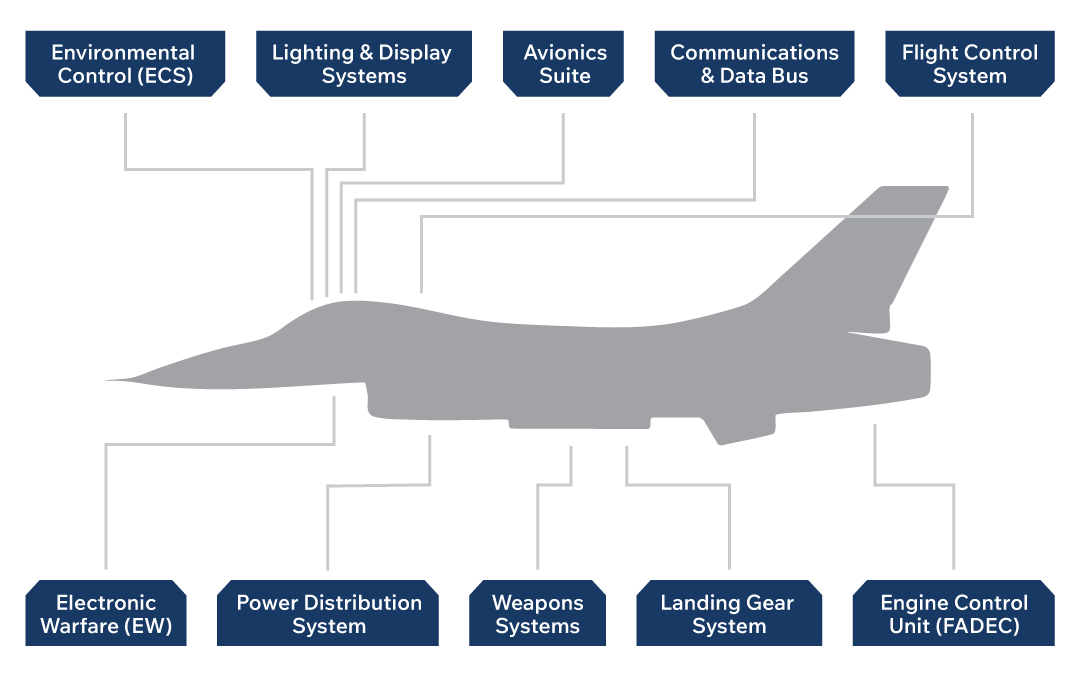
Figure 2: Digital combat aircraft like the F-16 integrate multiple mission-critical systems, from avionics and engine control to electronic warfare and environmental controls. Each subsystem depends on rugged, high-reliability interconnects to ensure real-time data exchange and system performance under extreme conditions.
Traditionally, pilots relied on mechanical instruments such as air pressure-based altimeters and gyroscopic attitude indicators, which required manual interpretation. With the advent of digital computing, these analog signals could be combined and displayed in integrated, real-time visual formats, ushering in the era of the glass cockpit. Today’s pilots, whether flying light aircraft or commercial airliners, rely on these full-color digital displays for immediate access to critical flight data.
The Unique Demands on Aerospace Interconnects
The F-16 introduced an innovation called relaxed stability, which improves maneuverability. However, this design relies heavily on flight computers to maintain control—highlighting the need for high-reliability interconnects. These computers monitor the movement of the aircraft and adjust its flight path many times every second. The pilot is no longer directly connected to the wing’s control surfaces. Instead, computers interpret the pilot’s input and convert these into instructions for the intended flight path.
| System | Function | Connector Requirements | Common Connector Types |
|---|---|---|---|
| Avionics Suite | Navigation, communication, radar, targeting systems | High-density, EMI shielded, vibration-resistant | MIL-DTL-38999, MIL-DTL-83513 |
| Flight Control System | Electronic signals from stick/pedals to control surfaces (fly-by-wire) | High reliability, real-time response, environmental sealing | MIL-DTL-38999, MIL-C-83723 |
| Power Distribution System | Distributes electrical power to subsystems | Current handling, shielding, harsh environment | MIL-C-26482, MIL-DTL-38999 |
| Engine Control Unit (FADEC) | Digital control of engine parameters | Heat and vibration resistance, signal integrity | MIL-DTL-38999, MIL-DTL-83513 |
| Weapons Systems | Missile & gun control, targeting interfaces | Secure locking, EMI protection, compact footprint | MIL-DTL-38999, MIL-PRF-49142 |
| Electronic Warfare (EW) | Radar warning, countermeasures | High-frequency RF, EMI-tight, sealed | MIL-DTL-3933, MIL-PRF-49142 |
| Communications & Data Bus | Voice/data link with ground and allied units | Signal fidelity, shielding, interoperability | MIL-DTL-24308, MIL-DTL-38999 |
| Environmental Control System (ECS) | Cockpit cooling, avionics bay temp control | Sealed, durable under vibration and pressure changes | MIL-C-26500, MIL-DTL-38999 |
| Landing Gear System | Retraction/deployment motors and sensors | Moisture/dirt resistance, compact | MIL-DTL-26482, MIL-C-83723 |
| Lighting & Display Systems | Cockpit displays, HUDs, exterior lights | Compact, high-cycle durability | MIL-DTL-38999, MIL-DTL-24308 |
Table 2: Critical Aerospace Subsystems and Connector Requirements in Modern Combat Aircraft.
These innovations are examples of how computing power has revolutionized aerospace and defense equipment design. However, the demand for high volumes of data between sensors, controllers and computers meant that traditional connectors were no longer equal to the task. This performance gap led directly to the development of a new standard: the MIL-DTL-38999 connector.
The MIL-DTL-38999 designation follows the U.S. Department of Defense standard taxonomy, where "DTL" refers to a detail specification, outlining exact design, performance, and testing criteria. This distinguishes it from MIL-PRF (performance specs) or MIL-C (older formats), underscoring its precision engineering focus.
The MIL-STD-D38999 Connector Series
At first inspection, the D38999 looks like previous designs. This circular type features lightweight aluminum alloy housings, which keep weight to a minimum in critical aerospace applications. In common with many older standards, the housing uses a screw or bayonet locking system to provide a secure and vibration-resistant connection.
Additionally, in the 1990s, a composite-shell variant of the D38999 was developed, offering notable improvements in weight reduction, mechanical durability, and corrosion resistance. Compared to aluminum shells, the composite version increased mating cycle durability from 500 to 1500 cycles by eliminating galling, while also boosting salt spray resistance ratings from 500 to 2000 hours thanks to its metalized plastic housing.
However, the most obvious difference between the D38999 and the styles that it replaced can be seen when looking at the mating face and its contacts. The electrical contacts, the core of every connector, are far smaller in the D38999 than older standards. This key difference reflects the roles played by the D38999 family, providing a greater contact density ideal for high-speed data connectors and fiber optic communications, especially in harsh environment connectors used in military and aerospace systems.
The D38999 is deployed in numerous mission-critical systems including the F-35 Lightning II, Eurofighter Typhoon, and NASA’s Orion capsule. These platforms rely on its compact footprint, EMI shielding, and reliable mating under vibration for avionics, propulsion, and data routing systems.
Connector Variants and Key Features
The D38999 family is split into several series:
- Series I – Scoop-proof, bayonet-locking system for quick, secure connections in rugged environments.
- Series II – Non-scoop-proof, low-profile bayonet-locking system for space-constrained applications.
- Series III – Scoop-proof, triple-start threaded coupling system with self-locking action that improves alignment and resists vibration.
- Series IV – Scoop-proof, breech-lock coupling system for high shock and vibration.

Figure 3: Visual comparison of the MIL-DTL-38999 connector series.
Several key features ensure that these connectors are easy to use, even in difficult or harsh conditions. The large threads on the outside of the receptacle are known as triple-start, which begin at three equidistant points around the housing. The connector is therefore easier to align during mating. The locking nut of the plug is designed to be easy to grip, even by hands wearing gloves. Finally, the threads are ratcheted, which ensures that they cannot become disconnected by accident or in applications exposed to vibration.
Supporting Today’s High-Speed, High-Reliability Systems
Today’s electronic systems demand not only ruggedization but also high-speed data throughput and minimal signal degradation. MIL-DTL-38999 connectors are increasingly required to support multi-gigabit transmission rates, manage signal integrity, and accommodate mixed-media formats, including fiber optics, RF, and 10G Base-T Ethernet, within confined envelopes.
As military avionics evolve to incorporate real-time processing and sensor fusion, the D38999’s ability to handle high-speed data and survive harsh environments makes it indispensable.
The rear of the connector housing is fitted with a screw thread to allow the fitting of an enormous range of accessories. These perform a variety of functions, from protecting against the elements and providing mechanical protection to shielding against unwanted electromagnetic interference.
Inside the housing, all members of the D38999 family use machined contacts to ensure the lowest electrical resistance while providing long-term mechanical reliability. The key to the versatility of the D38999 family is the choice of contact arrangement that can be specified. As microelectronics design has evolved over the decades, the D38999 has been updated to meet the latest demands.

Figure 4: Examples of MIL-DTL-38999 contact arrangements. These configurations support mixed-media formats, combining signal, power, RF, and fiber optic channels.
The contact arrangements now include options to combine power and signal, along with specialist functions such as coaxial and even optical fibre connections, while retaining the standardized mating dimensions that allow new designs to remain compatible with old equipment. This makes modernizing and upgrading simpler, both essential for ensuring that today’s equipment remains competitive tomorrow.
Micro-Miniaturization Without Compromise: The MD801 Advantage
A key challenge in using standard MIL-DTL-38999 connectors is their physical size. While they offer exceptional performance, protection, and reliability, even the smallest shell can be limiting in space-constrained designs. That’s why Cinch Connectivity Solutions developed the MD801 Series, a micro-miniaturized circular connector family that preserves D38999-level ruggedness while dramatically reducing its footprint.
MD801 connectors feature several shell sizes that are smaller than the smallest D38999, making them ideal for tight aerospace and defense applications. Beyond shell size, MD801 increases contact density with size 23 contacts, compared to size 22 in standard D38999, enabling designers to pack more performance into less space.
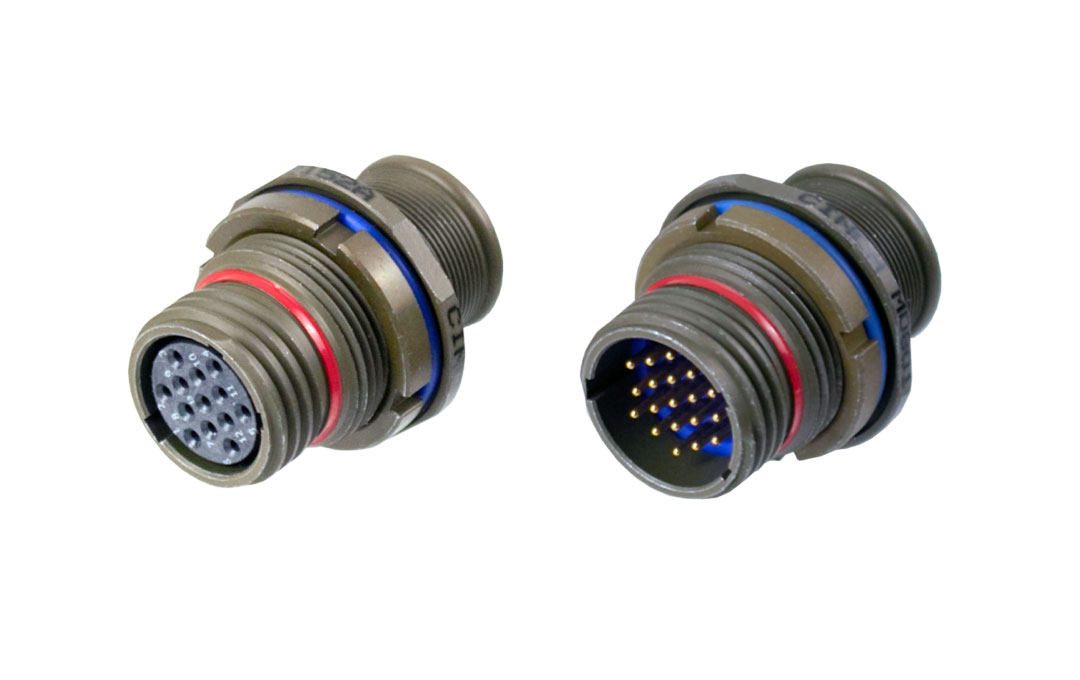
Figure 5: Cinch MD801 Series micro-miniature circular connectors. Built to MIL-DTL-38999 performance standards, these compact variants feature dual-start threads and lightweight housings.
These compact connectors use a dual-start ACME thread for fast mating and are available in lightweight aluminum or corrosion-resistant stainless-steel finishes. When SWaP optimization is critical, as in UAVs, next-gen launch vehicles, and embedded avionics systems, MD801 helps meet stringent electrical objectives using smaller, lighter components. Engineers looking to reduce harness bulk while maintaining full MIL-DTL-38999 compliance will find MD801 to be a high-value alternative.
Expanding Beyond Defense
The MIL-DTL-38999 family of connectors and its descendants, including ultra-compact variants like the MD801 Series, are among the most versatile interconnect designs in the marketplace. Originally engineered for rugged military and aerospace environments, these connectors now play an integral role in cutting-edge commercial programs.
Organizations such as NASA and SpaceX rely on both standard D38999 and space-optimized MD801 connectors for mission-critical applications, from launch systems to onboard avionics and environmental control modules. Their adoption into emerging technologies like autonomous systems, high-speed data buses, and miniaturized platforms for UAVs and wearable military tech further underscores their ongoing evolution.
As systems move toward modular open systems architectures (MOSA) and increasingly depend on AI-driven autonomous platforms, both D38999 and MD801 interconnects are continuing to evolve, enabling high-speed data buses, edge computing, and sensor fusion in next-generation defense and commercial systems.
Explore Cinch’s full portfolio of circular connectors, including derivatives of the rugged D38999 type interconnects and the ultra-compact MD801, engineered for performance in the world’s toughest environments.

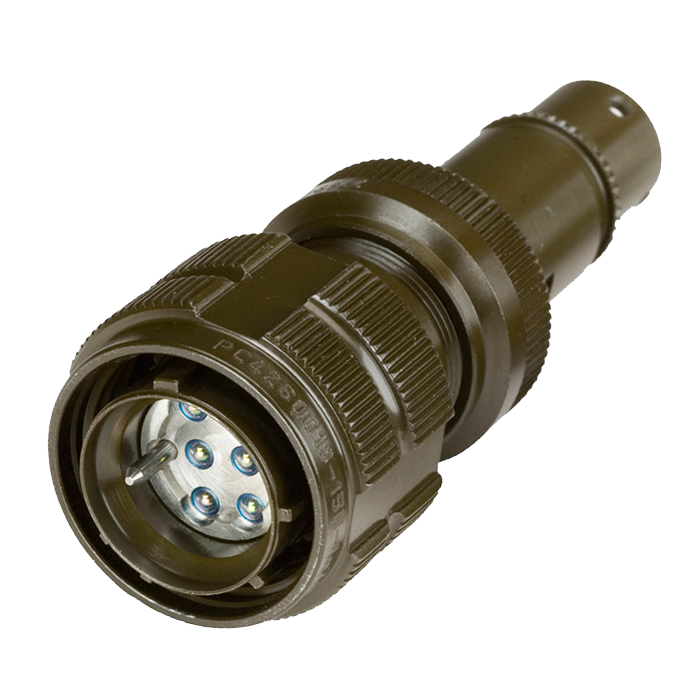 311B Family Expanded beam D38999
311B Family Expanded beam D38999
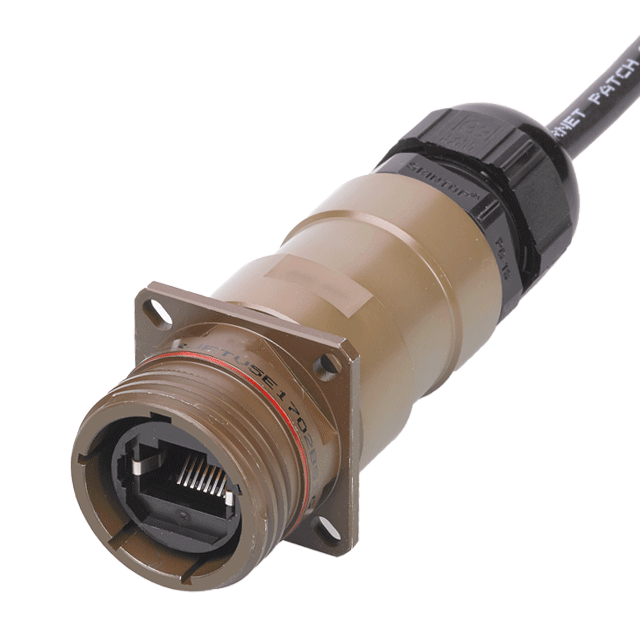 S-RJ Family RJ45 D38999
S-RJ Family RJ45 D38999
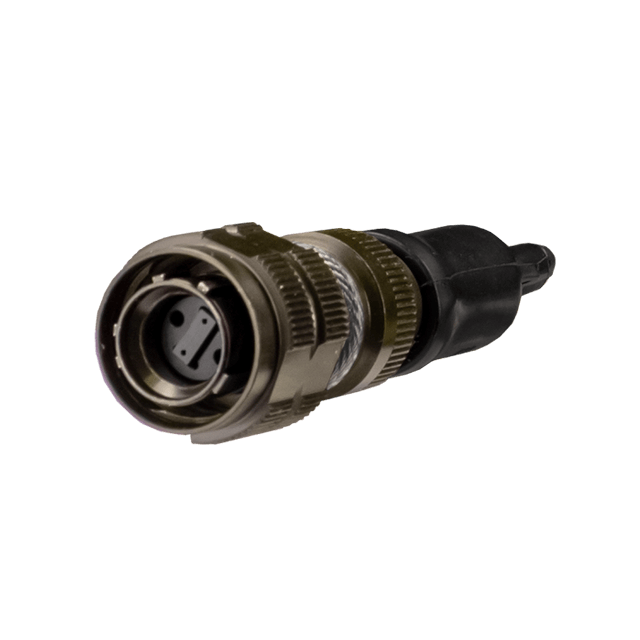 MT311 Family MT D38999
MT311 Family MT D38999
 MD801 Family – mini-38999
MD801 Family – mini-38999